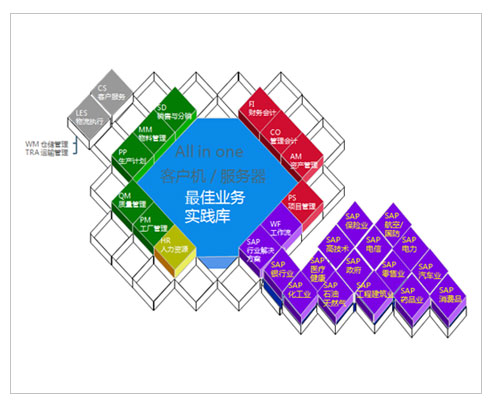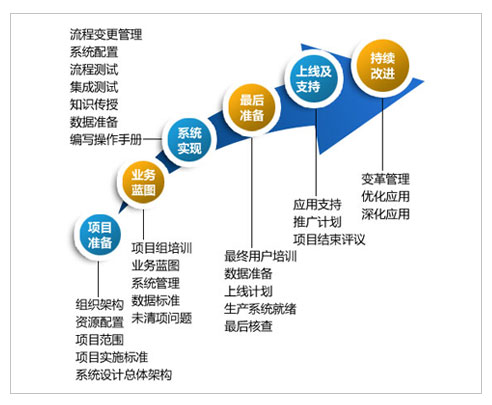 Overview
Overview
SAP is a global leader in ERP software with the world’s highest market share of software. The ERP software provided by SAP is a dedicated industry solution based on more than 1,000 proven best practices, helping companies to estimate goals and time, set prices, improve business operations, and unify the business goals with its IT strategy. It is also a business management solution that can be upgraded as the company grows.
Grid Electric specializes in providing SAP solutions for various industries, including traditional modules such as HR, FI, CO, MM, PP, PM, PS, and SD, as well as secondary development requirements tailored to customer needs. In addition, Grid Electric provides solutions such as BI, CRM, SCM and HANA in SAP Business Intelligence Package according to customer needs.
Grid Electric utilizes SAP technology platform and extensively cooperates with famous SAP consulting companies both at home and abroad to establish high-end services for product localization and remote support. The company has module implementation capabilities for FI, CO, MM, PS, PM, WF, HR, and BW, as well as technical support capabilities for ABAP and Basis. It is capable of full implementation of the SAP system from project preparation, blueprint design, system implementation, to customer support afterwards.
Functionalities of the Product
 The SAP FI Module (Financial Accounting Module) provides functions such as receivables, payables, general ledgers, mergers, investments, funds, and cash management. These functions can be adjusted according to the needs of each branch and are often multilingual. At the same time, the setting will follow the relevant regulations of particular country.
The SAP FI Module (Financial Accounting Module) provides functions such as receivables, payables, general ledgers, mergers, investments, funds, and cash management. These functions can be adjusted according to the needs of each branch and are often multilingual. At the same time, the setting will follow the relevant regulations of particular country.
The SAP CO Module (Controlling Module) includes functions such as profit and cost, product costs, project accounting, and profit analysis. It not only controls costs, but also affects the company's goals. It also provides information to help senior managers in the decision-making process.
The SAP TR Module (Treasury Module) manages cash budget, e-banking, financial status, position analysis, and mid-term forecasting. It is mainly composed of fund management (capital budgeting), cash budgeting, cash management, etc.
The SAP HR Module (Human Resources Module), which comprehensively manages personnel files and labor costs, mainly consists of personnel file management, organization management, time management, payroll accounting, organizational development, recruitment management, compensation and benefits management, human cost planning, balanced plan cards, training management, and travel expense management.
The SAP MM Module (Materials Management Module) is the logistics management based on materials (including services). It mainly consists of materials master data management, plan management, supplier management, procurement management, inventory management, warehouse management, bill management (invoice verification), etc.
The SAP PS Module (Project Management Module) is the integration of various systems, methods, and personnel to complete the project at the required quality within specified time and budget. It includes project planning, project budget, capacity planning, resource management, results analysis and other functions.
The SAP PM Module (Plant Maintenance Module) is the maintenance of complex plant control systems, which provides maintenance and inspection plans, exchange processing, historical data, and report analysis.
The SAP PP Module (Production Planning Module) enables management of plant data, production planning, MRP, capacity planning, and cost accounting, making companies effectively reduce inventory and improve efficiency. At the same time, the automatic connection of the original decentralized production processes enables the production process to be carried out in succession without production disconnection or production delivery time delay.
The SAP SD Module (Sales and Distribution Module) includes sales planning, quotation, order management, shipping delivery, invoices, etc. It can also effectively manage the distribution network.
The SAP WF Module (Workflow Management Module) provides functions such as job definition, flow management, e-mail, and information transfer automation.
The SAP QM Module (Quality Management Module) provides quality planning, quality inspection, quality control, and quality documentation.
Star Recommendation
Henan Electric Power Company ERP (SAP) System Project

In 2008, the company undertook the construction of Henan Province Electric Power Company's ERP (SAP) system promotion project in order to fully implement the State Grid SG186 project, to optimize the core business process of Henan Power, to build an integrated enterprise-level management system with vertical and horizontal integration, to realize centralized management of information resources such as people, finance, property, and project, and to fully improve the management level of Henan Electric Power.
The project uses the SAP standard implementation methodology as a guideline to build an ERP system covering project management, financial management, materials management, equipment management, and human resources management modules. The new system has enabled system integration and information sharing, improved the automation of business operations, optimized the division of responsibilities between departments and positions, and helped achieve corporate strategic objectives.
Case Overview
In 2010, Grid Electric fully participated in the promotion of UHV, the standardization of financial applications and human resources, as well as the application of each module in State Grid Shaanxi Electric Power. The company was responsible for the construction of the information network of State Grid Mengdong Electric Power, including the construction and further applications of ERP system, peer-to-peer system development and implementation, in-transit system operation and maintenance.
In 2011, Grid Electric fully participated in the ERP informatization of State Grid Shaanxi Electric Power, State Grid Henan Electric Power, State Grid Ningxia Electric Power, State Grid Mengdong Power and other State Grid provincial branches.
In 2012, Grid Electric comprehensively participated in the informatization of State Grid to support the “Five Major” adaptive adjustments, the informatization of “Three Intensives” of human, financial resources, and assets, and gradually participated in the operation and maintenance of power informatization in State Grid Shaanxi, and advanced ERP application in State Grid Mengdong.
In 2013, Grid Electric fully undertook the second phase of the construction of information support systems for State Grid Shaanxi, State Grid Jiangxi, State Grid Henan, and State Grid Mengdong. It also participated in the operation and maintenance of the “Three Intensives” informatization construction, ERP system implementation and other projects of State Grid Shaanxi as well as the county-level promotion of ERP system, “Three Intensives and Five Majors” adaptability adjustment and “Three Intensives” informatization projects of State Grid Henan. At the same time, Grid Electric participated in the centralized implementation of ERP system, the planning of the agricultural power unit of Chitong, the centralized adjustments of the information system and the “Three Intensives” informatization of State Grid Mengdong.
In 2014, Grid Electric continued to strengthen its information communication O&M technology capabilities while the scale of its personnel continued to expand. In 2015, Grid Electric further enhanced its capacities and upgraded its information communication O&M technologies, covering a wider range of topics, including information systems for human resources, finance, materials, planning, construction, maintenance, operation, marketing, and professional fields such as platform software, host, database, desktop, network, security, communications, etc.
In 2016, Grid Electric achieved remarkable progress in the O&M of information communication as well as professional and technical team building. A large number of outstanding talents emerged in the field of ERP, human resources, teaching and training, and other personnel-related systems. It is particularly gratifying that localization personnel have become the backbone of IT service and management team. Whether in working days or otherwise, local employees will respond to feedback promptly and perform on-site troubleshooting to improve the operations security of the system.